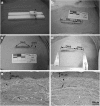The molecular mechanism of hypertrophic scar
- PMID: 23504443
- PMCID: PMC3889252
- DOI: 10.1007/s12079-013-0195-5
The molecular mechanism of hypertrophic scar
Abstract
Hypertrophic scar (HTS) is a dermal form of fibroproliferative disorder which often develops after thermal or traumatic injury to the deep regions of the skin and is characterized by excessive deposition and alterations in morphology of collagen and other extracellular matrix (ECM) proteins. HTS are cosmetically disfiguring and can cause functional problems that often recur despite surgical attempts to remove or improve the scars. In this review, the roles of various fibrotic and anti-fibrotic molecules are discussed in order to improve our understanding of the molecular mechanism of the pathogenesis of HTS. These molecules include growth factors, cytokines, ECM molecules, and proteolytic enzymes. By exploring the mechanisms of this form of dermal fibrosis, we seek to provide some insight into this form of dermal fibrosis that may allow clinicians to improve treatment and prevention in the future.
Figures





Similar articles
-
Novel methods for the investigation of human hypertrophic scarring and other dermal fibrosis.Methods Mol Biol. 2013;1037:203-31. doi: 10.1007/978-1-62703-505-7_11. Methods Mol Biol. 2013. PMID: 24029937
-
The Biology of Extracellular Matrix Proteins in Hypertrophic Scarring.Adv Wound Care (New Rochelle). 2022 May;11(5):234-254. doi: 10.1089/wound.2020.1257. Epub 2021 Jul 5. Adv Wound Care (New Rochelle). 2022. PMID: 33913776 Review.
-
A Novel Nude Mouse Model of Hypertrophic Scarring Using Scratched Full Thickness Human Skin Grafts.Adv Wound Care (New Rochelle). 2016 Jul 1;5(7):299-313. doi: 10.1089/wound.2015.0670. Adv Wound Care (New Rochelle). 2016. PMID: 27366591 Free PMC article.
-
Ameliorating Fibrotic Phenotypes of Keloid Dermal Fibroblasts through an Epidermal Growth Factor-Mediated Extracellular Matrix Remodeling.Int J Mol Sci. 2021 Feb 23;22(4):2198. doi: 10.3390/ijms22042198. Int J Mol Sci. 2021. PMID: 33672186 Free PMC article.
-
The Role of Chemokines in Fibrotic Wound Healing.Adv Wound Care (New Rochelle). 2015 Nov 1;4(11):673-686. doi: 10.1089/wound.2014.0550. Adv Wound Care (New Rochelle). 2015. PMID: 26543681 Free PMC article. Review.
Cited by
-
[Focused ultrasound therapy for reducing recurrence of vulvar lichen simplex chronicus in rats: efficacy and mechanism].Nan Fang Yi Ke Da Xue Xue Bao. 2019 Dec 30;39(12):1487-1493. doi: 10.12122/j.issn.1673-4254.2019.12.14. Nan Fang Yi Ke Da Xue Xue Bao. 2019. PMID: 31907152 Free PMC article. Chinese.
-
tRNA‑derived small RNAs: A novel class of small RNAs in human hypertrophic scar fibroblasts.Int J Mol Med. 2020 Jan;45(1):115-130. doi: 10.3892/ijmm.2019.4411. Epub 2019 Nov 25. Int J Mol Med. 2020. PMID: 31939611 Free PMC article.
-
Aberrantly expressed long noncoding RNAs in hypertrophic scar fibroblasts in vitro: A microarray study.Int J Mol Med. 2018 Apr;41(4):1917-1930. doi: 10.3892/ijmm.2018.3430. Epub 2018 Jan 26. Int J Mol Med. 2018. PMID: 29393369 Free PMC article.
-
Angiotensin II stimulates canonical TGF-β signaling pathway through angiotensin type 1 receptor to induce granulation tissue contraction.J Mol Med (Berl). 2015 Mar;93(3):289-302. doi: 10.1007/s00109-014-1211-9. Epub 2014 Oct 28. J Mol Med (Berl). 2015. PMID: 25345602 Free PMC article.
-
Long non-coding RNA (lncRNA) nuclear enriched abundant transcript 1 (NEAT1) regulates fibroblast growth factor receptor substrate 2 (FRS2) by targeting microRNA (miR)-29-3p in hypertrophic scar fibroblasts.Bioengineered. 2021 Dec;12(1):5210-5219. doi: 10.1080/21655979.2021.1959221. Bioengineered. 2021. PMID: 34414852 Free PMC article.
References
-
- Abe R, Donnelly SC, Peng T, Bucala R, Metz CN (2001) Peripheral blood fibrocytes: differentiation pathway and migration to wound sites. J Immunol 15;166(12):7556–7562 - PubMed
-
- Ahn ST, Monafo WW, Mustoe TA. Topical silicone gel: a new treatment for hypertrophic scars. Surgery. 1989;106(4):781–786. - PubMed
-
- Ali-Bahar M, Bauer B, Tredget EE, Ghahary A. Dermal fibroblasts from different layers of human skin are heterogeneous in expression of collagenase and types I and III procollagen mRNA. Wound Repair Regen. 2004;12(2):175–182. - PubMed
-
- Annes JP, Munger JS, Rifkin DB (2003) Making sense of latent TGFbeta activation. J Cell Sci 15;116(Pt 2):217–224 - PubMed
-
- Anzarut A, Olson J, Singh P, Rowe BH, Tredget EE. The effectiveness of pressure garment therapy for the prevention of abnormal scarring after burn injury: a meta-analysis. J Plast Reconstr Aesthet Surg. 2009;62(1):77–84. - PubMed
LinkOut - more resources
Full Text Sources
Other Literature Sources

